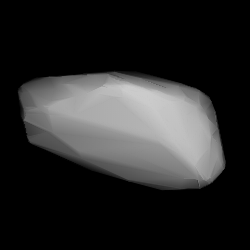 Shape model of Kaye from its lightcurve | |
| Discovery [1] | |
|---|---|
| Discovered by | A. Mrkos |
| Discovery site | Kleť Obs. |
| Discovery date | 24 February 1987 |
| Designations | |
| (6546) Kaye | |
Named after | Danny Kaye (American actor and singer)[2] |
| 1987 DY4 · 1978 RF2 1991 XM1 | |
| Orbital characteristics [3] | |
| Epoch 4 September 2017 (JD 2458000.5) | |
| Uncertainty parameter 0 | |
| Observation arc | 37.86 yr (13,828 days) |
| Aphelion | 3.5611 AU |
| Perihelion | 2.8844 AU |
| 3.2228 AU | |
| Eccentricity | 0.1050 |
| 5.79 yr (2,113 days) | |
| 80.178° | |
| 0° 10m 13.44s / day | |
| Inclination | 14.414° |
| 274.80° | |
| 272.41° | |
| Physical characteristics | |
Mean diameter | 21.624±0.174 km[8] 23.21 km (calculated)[4] 23.757±0.186 km[9] |
| 0.057 (assumed)[4] 0.0656±0.0078[9] 0.085±0.015[8] | |
| C (assumed)[4] | |
| 11.7[9] · 11.9[1][4] · 11.986±0.003 (R)[10] · 12.392±0.003 (S)[10] | |
6546 Kaye (prov. designation: 1987 DY4) is a dark and elongated background asteroid from the outer region of the asteroid belt. It was discovered on 24 February 1987, by Czech astronomer Antonín Mrkos at the South Bohemian Kleť Observatory in the Czech Republic.[3] The presumed C-type asteroid has a rotation period of 10.0 hours and measures approximately 22 kilometers (14 miles) in diameter. It was named for American actor Danny Kaye.[2]
Orbit and classification
When applying the synthetic hierarchical clustering method (HCM) by Nesvorný, or the 1995 HCM-analysis by Zappalà,[6] Kaye is a non-family asteroid of the main belt's background population,[5][6] while according to another HCM-analysis by Milani and Knežević (AstDyS),[7] it is a core member of the Ursula family (631), a family of 1,500 asteroids with a C- and X-type.[11]: 23
It orbits the Sun in the outer main-belt at a distance of 2.9–3.6 AU once every 5 years and 9 months (2,113 days). Its orbit has an eccentricity of 0.11 and an inclination of 14° with respect to the ecliptic.[1] It was first observed as 1978 RF2 at Crimea–Nauchnij in 1978, extending the body's observation arc by 9 years prior to its official discovery observation at Kleť Observatory.[3]
Naming
This minor planet was named in memory of American actor and singer David Daniel Kaminsky (1911–1987), known by his screen name as "Danny Kaye".[2] Kaye starred in popular feature films such as The Court Jester (1956), typically playing the role of a gentle bumbler who triumphs eventually. The minor planet's name was suggested by G. V. Williams, who made the identifications for this body.[2] The approved naming citation was published by the Minor Planet Center on 20 June 1997 (M.P.C. 30099).[12]
Physical characteristics
Rotation period
In August 2012, two rotational lightcurves of Kaye were obtained from photometric observations at the Palomar Transient Factory in California. Lightcurve analysis gave a rotation period of 10.0059±0.0569 and 10.0186±0.0569 hours with a brightness variation of 0.32 and 0.34 magnitude in the R and S-band, respectively (U=2/2).[4][10]
Diameter and albedo
According to the survey carried out by NASA's Wide-field Infrared Survey Explorer with its subsequent NEOWISE mission, Kaye measures between 21.6 and 23.8 kilometers in diameter and its surface has an albedo between 0.065 and 0.085.[8][9] The Collaborative Asteroid Lightcurve Link assumes a standard albedo for carbonaceous asteroids of 0.057 and calculates a diameter of 23.2 kilometers with an absolute magnitude of 11.9.[4]
References
- ^ a b c d "JPL Small-Body Database Browser: 6546 Kaye (1987 DY4)" (2016-07-18 last obs.). Jet Propulsion Laboratory. Archived from the original on 18 September 2020. Retrieved 21 June 2017.
- ^ a b c d Schmadel, Lutz D. (2007). "(6546) Kaye". Dictionary of Minor Planet Names. Springer Berlin Heidelberg. p. 540. doi:10.1007/978-3-540-29925-7_5941. ISBN 978-3-540-00238-3.
- ^ a b c d "6546 Kaye (1987 DY4)". Minor Planet Center. Retrieved 4 November 2016.
- ^ a b c d e f g h "LCDB Data for (6546) Kaye". Asteroid Lightcurve Database (LCDB). Retrieved 4 November 2016.
- ^ a b "Asteroid 6546 Kaye". Small Bodies Data Ferret. Retrieved 23 March 2020.
- ^ a b c Zappalà, V.; Bendjoya, Ph.; Cellino, A.; Farinella, P.; Froeschle, C. (1997). "Asteroid Dynamical Families". NASA Planetary Data System: EAR-A-5-DDR-FAMILY-V4.1. Retrieved 15 March 2020.} (PDS main page)
- ^ a b "Asteroid 6546 Kaye – Proper Elements". AstDyS-2, Asteroids – Dynamic Site. Retrieved 23 March 2020.
- ^ a b c Masiero, Joseph R.; Grav, T.; Mainzer, A. K.; Nugent, C. R.; Bauer, J. M.; Stevenson, R.; et al. (August 2014). "Main-belt Asteroids with WISE/NEOWISE: Near-infrared Albedos". The Astrophysical Journal. 791 (2): 11. arXiv:1406.6645. Bibcode:2014ApJ...791..121M. doi:10.1088/0004-637X/791/2/121. S2CID 119293330. Retrieved 4 November 2016.
- ^ a b c d Mainzer, A.; Grav, T.; Masiero, J.; Hand, E.; Bauer, J.; Tholen, D.; et al. (November 2011). "NEOWISE Studies of Spectrophotometrically Classified Asteroids: Preliminary Results". The Astrophysical Journal. 741 (2): 25. arXiv:1109.6407. Bibcode:2011ApJ...741...90M. doi:10.1088/0004-637X/741/2/90. S2CID 118700974.
- ^ a b c d e Waszczak, Adam; Chang, Chan-Kao; Ofek, Eran O.; Laher, Russ; Masci, Frank; Levitan, David; et al. (September 2015). "Asteroid Light Curves from the Palomar Transient Factory Survey: Rotation Periods and Phase Functions from Sparse Photometry". The Astronomical Journal. 150 (3): 35. arXiv:1504.04041. Bibcode:2015AJ....150...75W. doi:10.1088/0004-6256/150/3/75. S2CID 8342929. Retrieved 4 November 2016.
- ^ Nesvorný, D.; Broz, M.; Carruba, V. (December 2014). "Identification and Dynamical Properties of Asteroid Families". Asteroids IV. pp. 297–321. arXiv:1502.01628. Bibcode:2015aste.book..297N. doi:10.2458/azu_uapress_9780816532131-ch016. ISBN 9780816532131. S2CID 119280014.
- ^ "MPC/MPO/MPS Archive". Minor Planet Center. Retrieved 4 November 2016.
External links
- Lightcurve Database Query (LCDB), at www.minorplanet.info
- Dictionary of Minor Planet Names, Google books
- Asteroids and comets rotation curves, CdR – Geneva Observatory, Raoul Behrend
- Discovery Circumstances: Numbered Minor Planets (5001)-(10000) – Minor Planet Center
- 6546 Kaye at AstDyS-2, Asteroids—Dynamic Site
- 6546 Kaye at the JPL Small-Body Database
